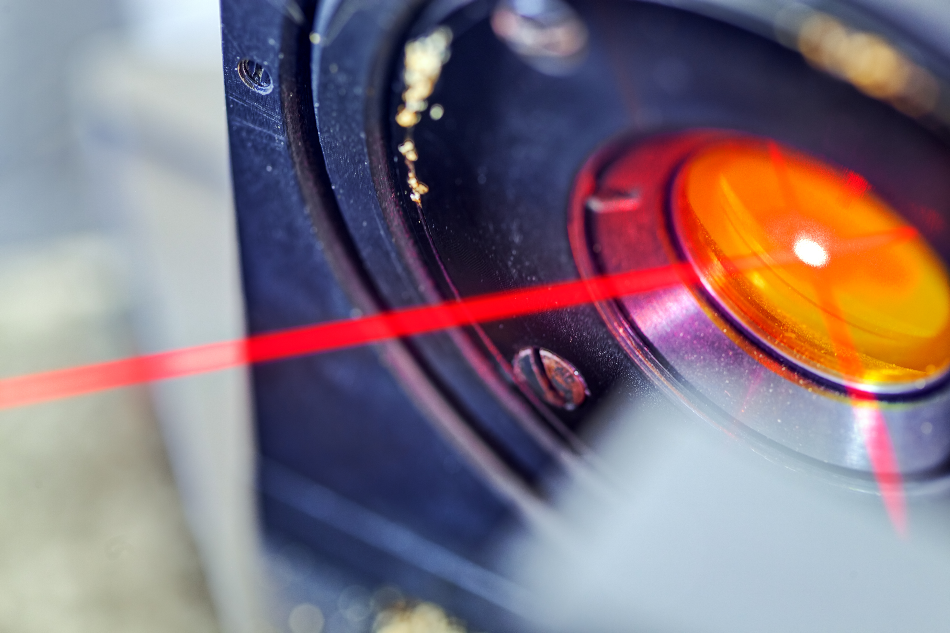
Image Credit: Vladimir Nenezic / Shutterstock.com
The free-electron laser was developed in 1971 and has slightly different operating mechanisms to other lasers. In basic terms, a free-electron laser utilizes a laser beam which is composed of high-speed electrons and photons—rather than just photons of light as in conventional lasers.
The electrons are also passed through a highly magnetized structure before coupling with the light waves, but don’t interact with the magnetic structure, hence the term ‘free-electron’.
What are Free-Electron Lasers?
Free-electron lasers are known to be highly tuneable lasers and have one of the widest bandwidths known of any laser class, with the ability to produce laser beams in the microwave, terahertz, infrared, visible, UV and X-ray regions of the electromagnetic spectrum. A free electron laser is composed of a few basic components, including an electron accelerator, a magnetic undulator, and an optical resonator, and it is these components that differentiate a free electron laser over other lasers.
The basic working mechanism is that the electrons radiate coherently between a magnetic structure, where the electrons are not bound to any medium, and the relativistic effects of the electrons take over to produce a high energy electron beam. This causes the electrons to exist and move freely, but there are many different components and factors which cause this to happen.
The Initial Energy of Electrons
The initial energy of the electrons is created by using an energy pump, and this creates electrons with high kinetic energy. To further increase the energy of the electrons, they are accelerated through a magnetic field—which is known as the undulator. The undulator has opposite poles either side of the electron beam, and this causes the electron beam wavelength to take on a sinusoidal (sine) form.
While in this magnetic field, the electrons exchange energy with the surrounding field, and this energy exchange creates electrons which are much higher in energy than the conventional electron. In the case of the higher energy electrons, their energies can be magnitudes of orders higher than the average electron.
While in the magnetic field, any electrons that lose energy from the energy exchange subsequently fall behind the other electrons which are moving with much higher energies. This causes the electron beam to become bunched, with higher energy electrons at the front and lower energy electrons at the back. This translates to a powerful synchrotron style radiation being produced that can have up to a few gigawatts of peak power.
As mentioned, a free-electron laser can be utilized in many different areas of the electromagnetic spectrum, and where the emitted wavelength falls within the electromagnetic spectrum depends on the energy of the electron, the properties of the undulator, and whether the laser has specific optical components.
In the case of where these components are not present, the free-electron laser is still tuneable, as the ability to change the strength of the magnetic field and initial energy from the pump enables electron beams of different energies to be realized—and the different energy electron beams ultimately give rise to wavelengths of light that are outputted by the laser.
Once the high energy electron beams have been formed, they subsequently become stimulated when they mix with wavelengths of light and this causes emissions to occur between high and low kinetic energies. Moreover, the motion of the electrons generates a high velocity that helps the electron beam to interact with the transverse electric field of the light wave, and this energy exchange between the electron and light wavelengths causes them to couple with each other.
The coupling strength between the two waves is dependent on the electric field strength of the coupled-wave. The high-intensity wave can then be used for different applications.
Light Amplification
The gain of the free-electron laser is proportional to the number of photons in the light wave and this is where the ‘light amplification’ comes from in the L.A.S.E.R. notation (Light Amplification by Stimulated Emission of Radiation). The light which emerges from the free-electron laser has many of the same properties as the light which comes from other types of lasers, especially in terms of there being a large number of coherent photons in a single mode.
The optical resonator is only used in certain scenarios, especially when a wavelength in and around the infrared and visible light spectrums is desired. However, they cannot be used if the wavelength of the light drops below 100 nm because the reflectivity of the resonator becomes non-existent (the reflectivity drops to zero) at such short wavelengths.
References and Further Reading
Disclaimer: The views expressed here are those of the author expressed in their private capacity and do not necessarily represent the views of AZoM.com Limited T/A AZoNetwork the owner and operator of this website. This disclaimer forms part of the Terms and conditions of use of this website.